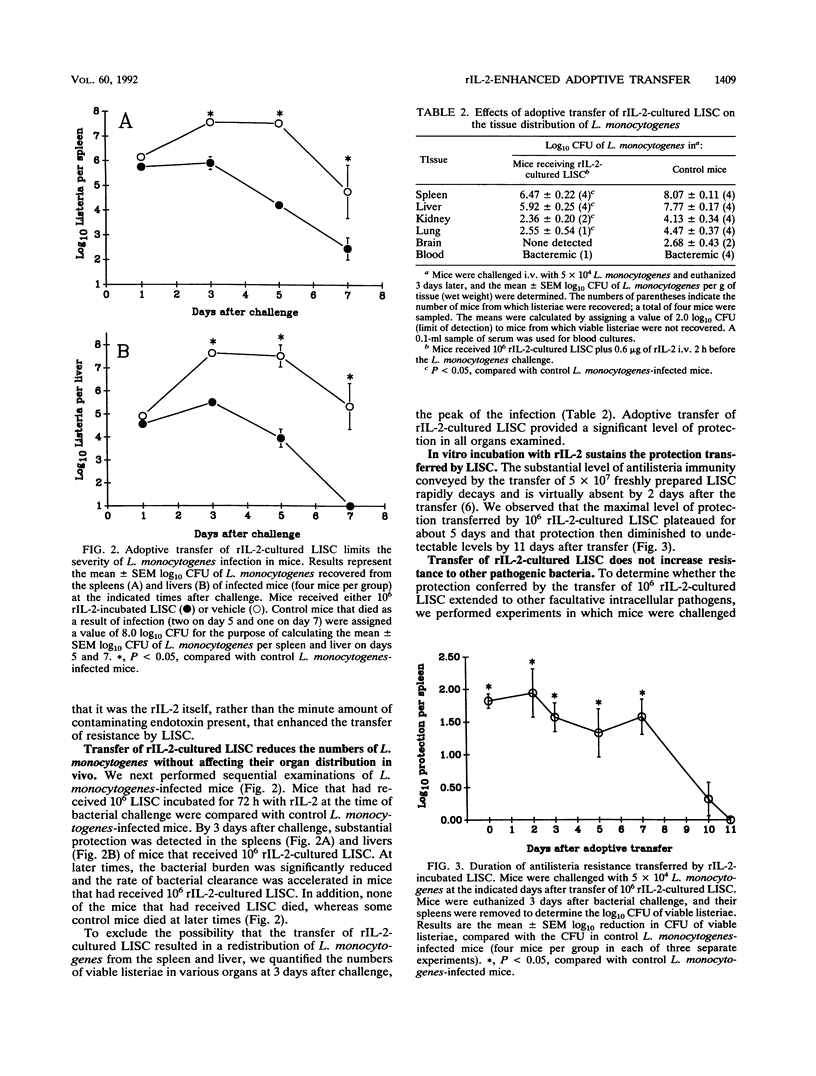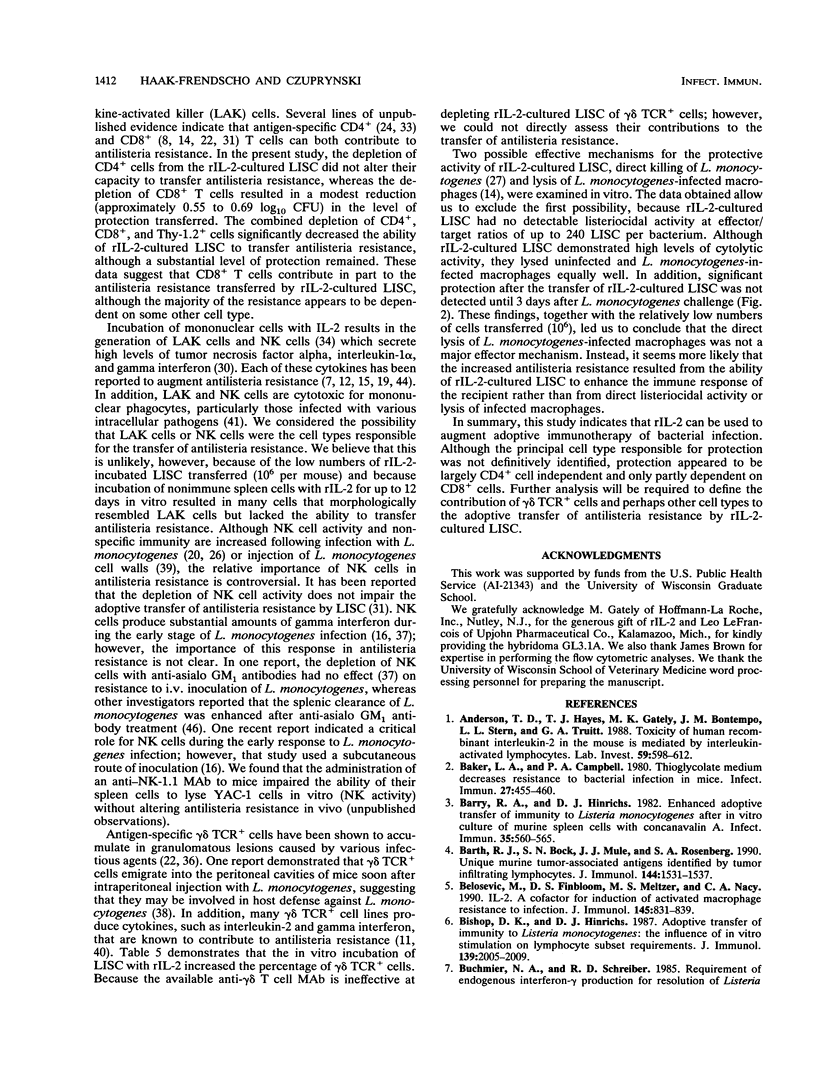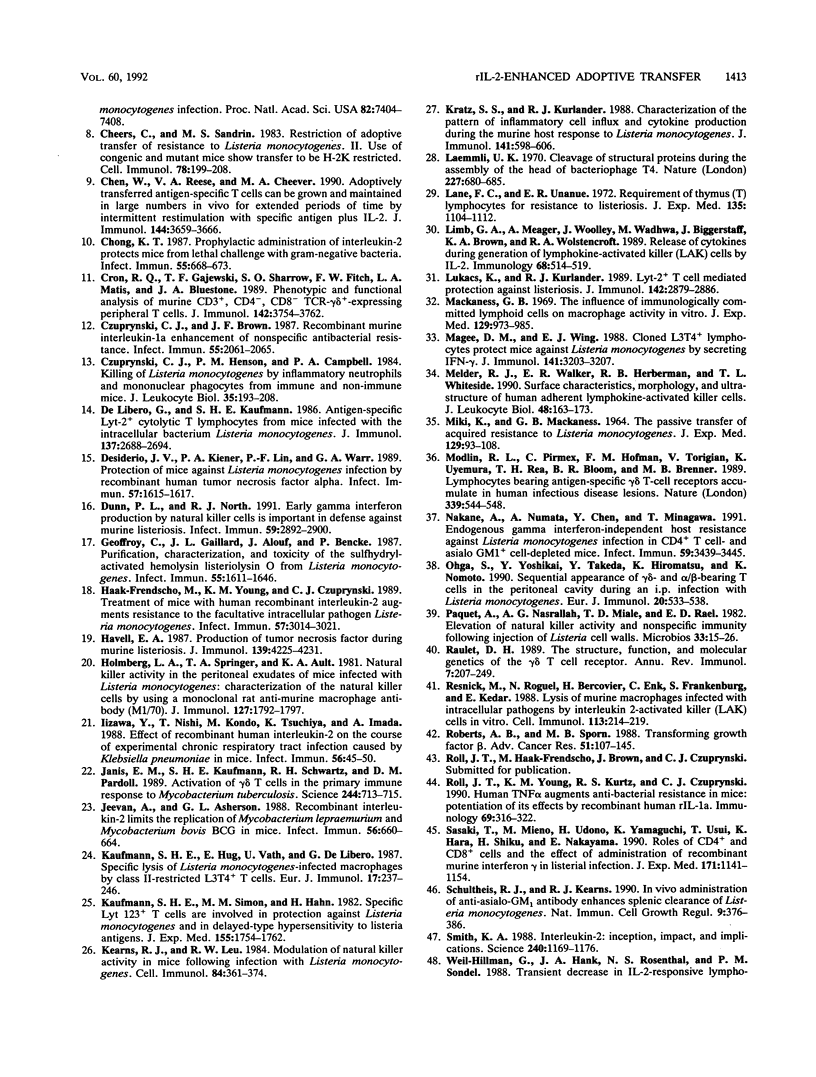Abstract
In vitro incubation of Listeria-immune spleen cells (LISC) with recombinant interleukin-2 (rIL-2) for at least 3 days increased their ability to transfer antilisteria resistance to recipient mice. This effect was blocked by the in vitro addition of transforming growth factor beta 1. The level of protection afforded by the transfer of rIL-2-incubated LISC was further elevated by the in vivo administration of rIL-2 at a dose that by itself did not significantly increase antilisteria resistance. The antilisteria resistance of recipient mice remained elevated for approximately 7 days and then rapidly declined to undetectable levels by 10 days. After cell transfer, recipient mice were protected against challenge with Listeria monocytogenes but not Salmonella typhimurium, Yersinia enterocolitica, or Streptococcus pyogenes. Flow cytometric analyses revealed an increase in the percentages of CD8+, NK+, and gamma delta T cell receptor+ cells but no change in the percentage of CD4+ cells as a result of LISC coculturing with rIL-2. In vitro depletion of CD4+ cells just prior to transfer had no significant effect on the adoptive transfer of resistance; depletion of CD8+ cells reduced the level of resistance by approximately 25%. Combined depletion of Thy-1.2+, CD4+, and CD8+ cells just prior to adoptive transfer diminished the level of protection in the spleens but not the livers of recipient mice. These data suggest that rIL-2 can be used to augment adoptive immunotherapy for bacterial infection in a manner similar to adoptive immunotherapy of human cancer patients. Although the protective cell population was not definitively identified, it appeared to be independent of CD4+ cells and only partly dependent on CD8+ cells.
Full text
PDF








Selected References
These references are in PubMed. This may not be the complete list of references from this article.
- Anderson T. D., Hayes T. J., Gately M. K., Bontempo J. M., Stern L. L., Truitt G. A. Toxicity of human recombinant interleukin-2 in the mouse is mediated by interleukin-activated lymphocytes. Separation of efficacy and toxicity by selective lymphocyte subset depletion. Lab Invest. 1988 Nov;59(5):598–612. [PubMed] [Google Scholar]
- Baker L. A., Campbell P. A. Thioglycolate medium decreases resistance to bacterial infection in mice. Infect Immun. 1980 Feb;27(2):455–460. doi: 10.1128/iai.27.2.455-460.1980. [DOI] [PMC free article] [PubMed] [Google Scholar]
- Barry R. A., Hinrichs D. J. Enhanced adoptive transfer of immunity to Listeria monocytogenes after in vitro culture of murine spleen cells with concanavalin A. Infect Immun. 1982 Feb;35(2):560–565. doi: 10.1128/iai.35.2.560-565.1982. [DOI] [PMC free article] [PubMed] [Google Scholar]
- Barth R. J., Jr, Bock S. N., Mulé J. J., Rosenberg S. A. Unique murine tumor-associated antigens identified by tumor infiltrating lymphocytes. J Immunol. 1990 Feb 15;144(4):1531–1537. [PubMed] [Google Scholar]
- Belosevic M., Finbloom D. S., Meltzer M. S., Nacy C. A. IL-2. A cofactor for induction of activated macrophage resistance to infection. J Immunol. 1990 Aug 1;145(3):831–839. [PubMed] [Google Scholar]
- Bishop D. K., Hinrichs D. J. Adoptive transfer of immunity to Listeria monocytogenes. The influence of in vitro stimulation on lymphocyte subset requirements. J Immunol. 1987 Sep 15;139(6):2005–2009. [PubMed] [Google Scholar]
- Buchmeier N. A., Schreiber R. D. Requirement of endogenous interferon-gamma production for resolution of Listeria monocytogenes infection. Proc Natl Acad Sci U S A. 1985 Nov;82(21):7404–7408. doi: 10.1073/pnas.82.21.7404. [DOI] [PMC free article] [PubMed] [Google Scholar]
- Cheers C., Sandrin M. S. Restriction in adoptive transfer of resistance to Listeria monocytogenes. II. Use of congenic and mutant mice show transfer to be H-2K restricted. Cell Immunol. 1983 Jun;78(2):199–205. doi: 10.1016/0008-8749(83)90274-5. [DOI] [PubMed] [Google Scholar]
- Chen W., Reese V. A., Cheever M. A. Adoptively transferred antigen-specific T cells can be grown and maintained in large numbers in vivo for extended periods of time by intermittent restimulation with specific antigen plus IL-2. J Immunol. 1990 May 15;144(10):3659–3666. [PubMed] [Google Scholar]
- Chong K. T. Prophylactic administration of interleukin-2 protects mice from lethal challenge with gram-negative bacteria. Infect Immun. 1987 Mar;55(3):668–673. doi: 10.1128/iai.55.3.668-673.1987. [DOI] [PMC free article] [PubMed] [Google Scholar]
- Cron R. Q., Gajewski T. F., Sharrow S. O., Fitch F. W., Matis L. A., Bluestone J. A. Phenotypic and functional analysis of murine CD3+,CD4-,CD8- TCR-gamma delta-expressing peripheral T cells. J Immunol. 1989 Jun 1;142(11):3754–3762. [PubMed] [Google Scholar]
- Czuprynski C. J., Brown J. F. Recombinant murine interleukin-1 alpha enhancement of nonspecific antibacterial resistance. Infect Immun. 1987 Sep;55(9):2061–2065. doi: 10.1128/iai.55.9.2061-2065.1987. [DOI] [PMC free article] [PubMed] [Google Scholar]
- Czuprynski C. J., Henson P. M., Campbell P. A. Killing of Listeria monocytogenes by inflammatory neutrophils and mononuclear phagocytes from immune and nonimmune mice. J Leukoc Biol. 1984 Feb;35(2):193–208. doi: 10.1002/jlb.35.2.193. [DOI] [PubMed] [Google Scholar]
- De Libero G., Kaufmann S. H. Antigen-specific Lyt-2+ cytolytic T lymphocytes from mice infected with the intracellular bacterium Listeria monocytogenes. J Immunol. 1986 Oct 15;137(8):2688–2694. [PubMed] [Google Scholar]
- Desiderio J. V., Kiener P. A., Lin P. F., Warr G. A. Protection of mice against Listeria monocytogenes infection by recombinant human tumor necrosis factor alpha. Infect Immun. 1989 May;57(5):1615–1617. doi: 10.1128/iai.57.5.1615-1617.1989. [DOI] [PMC free article] [PubMed] [Google Scholar]
- Dunn P. L., North R. J. Early gamma interferon production by natural killer cells is important in defense against murine listeriosis. Infect Immun. 1991 Sep;59(9):2892–2900. doi: 10.1128/iai.59.9.2892-2900.1991. [DOI] [PMC free article] [PubMed] [Google Scholar]
- Geoffroy C., Gaillard J. L., Alouf J. E., Berche P. Purification, characterization, and toxicity of the sulfhydryl-activated hemolysin listeriolysin O from Listeria monocytogenes. Infect Immun. 1987 Jul;55(7):1641–1646. doi: 10.1128/iai.55.7.1641-1646.1987. [DOI] [PMC free article] [PubMed] [Google Scholar]
- Haak-Frendscho M., Young K. M., Czuprynski C. J. Treatment of mice with human recombinant interleukin-2 augments resistance to the facultative intracellular pathogen Listeria monocytogenes. Infect Immun. 1989 Oct;57(10):3014–3021. doi: 10.1128/iai.57.10.3014-3021.1989. [DOI] [PMC free article] [PubMed] [Google Scholar]
- Havell E. A. Production of tumor necrosis factor during murine listeriosis. J Immunol. 1987 Dec 15;139(12):4225–4231. [PubMed] [Google Scholar]
- Holmberg L. A., Springer T. A., Ault K. A. Natural killer activity in the peritoneal exudates of mice infected with Listeria monocytogenes: characterization of the natural killer cells by using a monoclonal rat anti-murine macrophage antibody (M1/70). J Immunol. 1981 Nov;127(5):1792–1799. [PubMed] [Google Scholar]
- Iizawa Y., Nishi T., Kondo M., Tsuchiya K., Imada A. Effect of recombinant human interleukin-2 on the course of experimental chronic respiratory tract infection caused by Klebsiella pneumoniae in mice. Infect Immun. 1988 Jan;56(1):45–50. doi: 10.1128/iai.56.1.45-50.1988. [DOI] [PMC free article] [PubMed] [Google Scholar]
- Janis E. M., Kaufmann S. H., Schwartz R. H., Pardoll D. M. Activation of gamma delta T cells in the primary immune response to Mycobacterium tuberculosis. Science. 1989 May 12;244(4905):713–716. doi: 10.1126/science.2524098. [DOI] [PubMed] [Google Scholar]
- Jeevan A., Asherson G. L. Recombinant interleukin-2 limits the replication of Mycobacterium lepraemurium and Mycobacterium bovis BCG in mice. Infect Immun. 1988 Mar;56(3):660–664. doi: 10.1128/iai.56.3.660-664.1988. [DOI] [PMC free article] [PubMed] [Google Scholar]
- Kaufmann S. H., Hahn H. Biological functions of t cell lines with specificity for the intracellular bacterium Listeria monocytogenes in vitro and in vivo. J Exp Med. 1982 Jun 1;155(6):1754–1765. doi: 10.1084/jem.155.6.1754. [DOI] [PMC free article] [PubMed] [Google Scholar]
- Kaufmann S. H., Hug E., Väth U., De Libero G. Specific lysis of Listeria monocytogenes-infected macrophages by class II-restricted L3T4+ T cells. Eur J Immunol. 1987 Feb;17(2):237–246. doi: 10.1002/eji.1830170214. [DOI] [PubMed] [Google Scholar]
- Kearns R. J., Leu R. W. Modulation of natural killer activity in mice following infection with Listeria monocytogenes. Cell Immunol. 1984 Apr 1;84(2):361–371. doi: 10.1016/0008-8749(84)90108-4. [DOI] [PubMed] [Google Scholar]
- Kratz S. S., Kurlander R. J. Characterization of the pattern of inflammatory cell influx and cytokine production during the murine host response to Listeria monocytogenes. J Immunol. 1988 Jul 15;141(2):598–606. [PubMed] [Google Scholar]
- Laemmli U. K. Cleavage of structural proteins during the assembly of the head of bacteriophage T4. Nature. 1970 Aug 15;227(5259):680–685. doi: 10.1038/227680a0. [DOI] [PubMed] [Google Scholar]
- Lane F. C., Unanue E. R. Requirement of thymus (T) lymphocytes for resistance to listeriosis. J Exp Med. 1972 May 1;135(5):1104–1112. doi: 10.1084/jem.135.5.1104. [DOI] [PMC free article] [PubMed] [Google Scholar]
- Limb G. A., Meager A., Woolley J., Wadhwa M., Biggerstaff J., Brown K. A., Wolstencroft R. A. Release of cytokines during generation of lymphokine-activated killer (LAK) cells by IL-2. Immunology. 1989 Dec;68(4):514–519. [PMC free article] [PubMed] [Google Scholar]
- Lukacs K., Kurlander R. Lyt-2+ T cell-mediated protection against listeriosis. Protection correlates with phagocyte depletion but not with IFN-gamma production. J Immunol. 1989 Apr 15;142(8):2879–2886. [PubMed] [Google Scholar]
- MIKI K., MACKANESS G. B. THE PASSIVE TRANSFER OF ACQUIRED RESISTANCE TO LISTERIA MONOCYTOGENES. J Exp Med. 1964 Jul 1;120:93–103. doi: 10.1084/jem.120.1.93. [DOI] [PMC free article] [PubMed] [Google Scholar]
- Mackaness G. B. The influence of immunologically committed lymphoid cells on macrophage activity in vivo. J Exp Med. 1969 May 1;129(5):973–992. doi: 10.1084/jem.129.5.973. [DOI] [PMC free article] [PubMed] [Google Scholar]
- Magee D. M., Wing E. J. Cloned L3T4+ T lymphocytes protect mice against Listeria monocytogenes by secreting IFN-gamma. J Immunol. 1988 Nov 1;141(9):3203–3207. [PubMed] [Google Scholar]
- Melder R. J., Walker E. R., Herberman R. B., Whiteside T. L. Surface characteristics, morphology, and ultrastructure of human adherent lymphokine-activated killer cells. J Leukoc Biol. 1990 Aug;48(2):163–173. doi: 10.1002/jlb.48.2.163. [DOI] [PubMed] [Google Scholar]
- Modlin R. L., Pirmez C., Hofman F. M., Torigian V., Uyemura K., Rea T. H., Bloom B. R., Brenner M. B. Lymphocytes bearing antigen-specific gamma delta T-cell receptors accumulate in human infectious disease lesions. Nature. 1989 Jun 15;339(6225):544–548. doi: 10.1038/339544a0. [DOI] [PubMed] [Google Scholar]
- Nakane A., Numata A., Chen Y., Minagawa T. Endogenous gamma interferon-independent host resistance against Listeria monocytogenes infection in CD4+ T cell- and asialo GM1+ cell-depleted mice. Infect Immun. 1991 Oct;59(10):3439–3445. doi: 10.1128/iai.59.10.3439-3445.1991. [DOI] [PMC free article] [PubMed] [Google Scholar]
- Ohga S., Yoshikai Y., Takeda Y., Hiromatsu K., Nomoto K. Sequential appearance of gamma/delta- and alpha/beta-bearing T cells in the peritoneal cavity during an i.p. infection with Listeria monocytogenes. Eur J Immunol. 1990 Mar;20(3):533–538. doi: 10.1002/eji.1830200311. [DOI] [PubMed] [Google Scholar]
- Paquet A., Jr, Nasrallah A. G., Miale T. D., Rael E. D. Elevation of natural killer activity and nonspecific immunity following injection of Listeria cell walls. Microbios. 1982;33(131):15–26. [PubMed] [Google Scholar]
- Raulet D. H. The structure, function, and molecular genetics of the gamma/delta T cell receptor. Annu Rev Immunol. 1989;7:175–207. doi: 10.1146/annurev.iy.07.040189.001135. [DOI] [PubMed] [Google Scholar]
- Resnick M., Roguel N., Bercovier H., Enk C., Frankenburg S., Kedar E. Lysis of murine macrophages infected with intracellular pathogens by interleukin 2-activated killer (LAK) cells in vitro. Cell Immunol. 1988 Apr 15;113(1):214–219. doi: 10.1016/0008-8749(88)90019-6. [DOI] [PubMed] [Google Scholar]
- Roberts A. B., Sporn M. B. Transforming growth factor beta. Adv Cancer Res. 1988;51:107–145. [PubMed] [Google Scholar]
- Roll J. T., Young K. M., Kurtz R. S., Czuprynski C. J. Human rTNF alpha augments anti-bacterial resistance in mice: potentiation of its effects by recombinant human rIL-1 alpha. Immunology. 1990 Feb;69(2):316–322. [PMC free article] [PubMed] [Google Scholar]
- Sasaki T., Mieno M., Udono H., Yamaguchi K., Usui T., Hara K., Shiku H., Nakayama E. Roles of CD4+ and CD8+ cells, and the effect of administration of recombinant murine interferon gamma in listerial infection. J Exp Med. 1990 Apr 1;171(4):1141–1154. doi: 10.1084/jem.171.4.1141. [DOI] [PMC free article] [PubMed] [Google Scholar]
- Schultheis R. J., Kearns R. J. In vivo administration of anti-asialo-GM1 antibody enhances splenic clearance of Listeria monocytogenes. Nat Immun Cell Growth Regul. 1990;9(6):376–386. [PubMed] [Google Scholar]
- Smith K. A. Interleukin-2: inception, impact, and implications. Science. 1988 May 27;240(4856):1169–1176. doi: 10.1126/science.3131876. [DOI] [PubMed] [Google Scholar]
- Weil-Hillman G., Hank J. A., Rosenthal N. S., Sondel P. M. Transient decrease in IL-2-responsive lymphocytes 24 hours after initiation of continuous IL-2 infusion in cancer patients. J Biol Response Mod. 1988 Oct;7(5):424–437. [PubMed] [Google Scholar]
- Youdim S., Stutman O., Good R. A. Studies of delayed hypersensitivity to L. Monocytogenes in mice: nature of cells involved in passive transfers. Cell Immunol. 1973 Jan;6(1):98–109. doi: 10.1016/0008-8749(73)90010-5. [DOI] [PubMed] [Google Scholar]
- Ziegler K., Unanue E. R. Identification of a macrophage antigen-processing event required for I-region-restricted antigen presentation to T lymphocytes. J Immunol. 1981 Nov;127(5):1869–1875. [PubMed] [Google Scholar]
- Zinkernagel R. M., Althage A., Adler B., Blanden R. V., Davidson W. F., Kees U., Dunlop M. B., Shreffler D. C. H-2 restriction of cell-mediated immunity to an intracellular bacterium: effector T cells are specific for Listeria antigen in association with H-21 region-coded self-markers. J Exp Med. 1977 May 1;145(5):1353–1367. doi: 10.1084/jem.145.5.1353. [DOI] [PMC free article] [PubMed] [Google Scholar]


